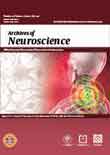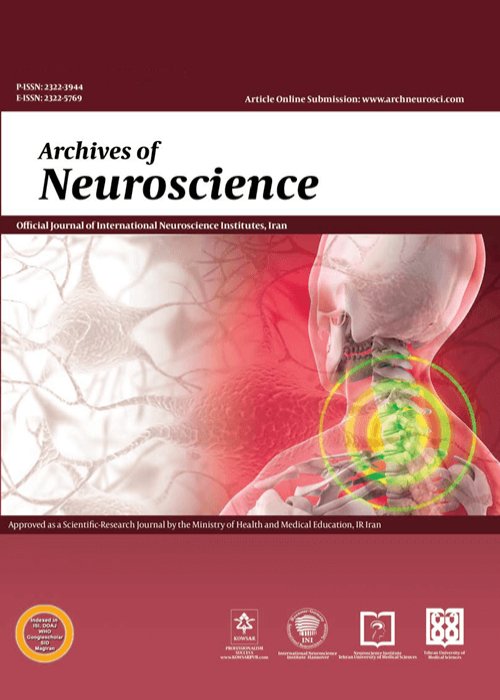فهرست مطالب

Archives of Neuroscience
Volume:4 Issue: 4, Oct 2017
- تاریخ انتشار: 1396/09/11
- تعداد عناوین: 10
-
-
Page 1Several trials have evaluated the role of treatment with beta-blockers in patients undergoing non-cardiac surgery. Debates are when and which agent and dosage to initiate and when and how to continue or discontinue. In addition, effects on perioperative arrhythmia, myocardial infarction, stroke, and mortality were studied. Herein we have tried to review the most common guidelines and large trials on the aforementioned issues.Keywords: Beta, Blocker, Non, Cardiac Surgery, Myocardial Infarction, Death
-
Page 2BackgroundDetermining the impact of executive dysfunction on reading defects in children with reading and learning disabilities can tremenddously help their treatment. In the recent decade, the role of executive functions has been considered very important and fundamental; following those considerations, therefore, the aim of this study is to determine the relationship between executive functions and problems with reading in children with specific learning disorders.ObjectivesThis study aims to investigate the relationship between executive functions with reading difficulties in children with specific learning disorders.MethodsIn this cross-sectional study, 29 children with specific learning disorders were selected by the NAMA Reading and Dyslexia Test. The Tower of London test, the Stroop Color and Word test, and the Wisconsin Sorting Card test were then utilized to test the subjects. To analyze the data, the Partial Least Squares method was used with PResultsOur study showed that in children with specific learning disorders there were significant relationships between selective attention and reading problems (PDiscussionThe results of this study suggest that executive functions play an important role in reading problems of children with a specific learning disorder. In treating these children,, considerable attention should be paid to improve the executive functions.Keywords: Specific Learning Disorder, Executive Functions, Educational Difficulties
-
Page 3BackgroundGeneralized anxiety disorder (GAD) is known as the most prevalent anxiety disorder. Saffron has been previously approved as an effective adjuvant therapy in depression and might alleviate GAD symptoms.MethodsIn the current double blind randomized controlled trial, 40 patients with mild to moderate GAD, diagnosed according to the diagnostic and statistical manual of mental disorders-V (DSM-V) and received sertraline were randomly assigned to the saffron receiving group (450 mg, n = 20) or placebo taking patients (n = 20). Interventions were administered as an add-on therapy to sertraline on a daily bases for 6 weeks. In addition to assessing anthropometric, demographic data, and dietary intakes of patients, a 14-item Hamilton anxiety rating scale (HAM-A) was used to assess the effect of treatment.ResultsThe mean (SD) of age was 29.65 (8.45) and 32.40 (6.74) years in the Saffron and placebo groups, respectively. Applying ANCOVA models adjusted for age, baseline energy intake, HAM-A total score, and weight changes from baseline to the 6th week, showed that at the end of the 6th week, saffron treated patients had a significantly lower mean HAM-A score compared to placebo group (2.95 vs. 5.05; P value = 0.005). Furthermore, within the group analysis it was shown that the total HAM-A score significantly declined in both groups (P value ≤ 0.000). Measuring changes in the HAM-A total score, relative to the baseline, following adjustment of ANCOVA models, showed that saffron was more effective than the placebo in reducing the mean HAM-A score of patients (-17.25 ± 2.67 vs. -15.35 ± 2.30; P value = 0.029). The side effects were tolerable and did not result in discontinuation of the supplementation.ConclusionsSaffron as a sertraline add-on therapy may attenuate GAD symptoms. However, more randomized clinical trials with a larger sample size and longer duration of follow-up are needed to confirm this effect.Keywords: Generalized Anxiety Disorder (GAD), Saffron, Crocus sativus L
-
Page 4BackgroundPituitary adenomas are the most common space-occupying lesions in the sellar region. Pituitary adenomas are usually soft, but 5 to 13% of macroadenomas are fibrous. The resection of firm tumors by curettage or suction is challenging. Therefore, preoperative knowledge of the pituitary adenomas consistency could help neurosurgeons plan more appropriate surgical procedures. In this regard, predicting fibrous adenomas by magnetic resonance imaging (MRI) is typically difficult and the results are controversial. We evaluated the correlation of pituitary adenoma consistency during tumor resection with preoperative diffusion-weighted images (DWI) findings and apparent diffusion coefficient (ADC) values.Methods45 consecutive patients (21 male, 24 female, mean age 43 ± 10) with pituitary macroadenoma were prospectively enrolled. Radiological evaluation with conventional MR and DWI images was done for all patients. Tumor consistency was evaluated at surgery and classified as soft, intermediated, and hard. Histological examination was performed on tumor specimens.ResultsBased on the surgical findings, 12 (26.7%) tumors were classified as soft-, 30 (66.6%) as intermediate-, and 3 (6.7%) as hard-consistency macroadenomas. Although the collagen content showed an association with tumor consistency, neither tumor consistency nor collagen content and secretory status were correlated with conventional MRI measures and ADCs in different b values and planes.ConclusionsPreoperative DW MRI was not useful to predict the tumor consistency, collagen content, and hormone-secreting status of pituitary macroadenomas.Keywords: Apparent Diffusion Coefficient, Diffusion Magnetic Resonance Imaging, Pituitary Adenoma, Transsphenoidal Surgery, Tumor Consistency
-
Page 5BackgroundSeated position is a debated position for posterior fossa and cervical spine procedures. This study was designed to monitor cerebral oxygenation and hemodynamic changes in seated position neurosurgical procedures.MethodsNinety-five candidates for elective craniotomies in seated position were included. Before the sitting positioning patients received isotonic crystalloid fluid and a vasoconstrictor agent, if necessary. The applied seated position in this study was a modified sitting position so that the legs were elevated to the point that toes were at the Tragus level. Mean Arterial Pressure (MAP), regional cerebral oxygen saturation level (rSO2) and end tidal CO2 were recorded before anesthesia induction until the end of surgery.ResultsFifteen minutes after the establishment of the sitting position, there was a statistically significant decrease in rSO2 compared with the pre-sitting time (67.30 ± 9.21 vs 68.24 ± 8.96) (P = 0.037). Furthermore, in comparison with pre-sitting time, a decrease in MAP on the 15th minute after sitting positioning was observed (66.55 ± 11.52 versus 69.88 ± 11.51) (P = 0.018). The incidence of Cerebral Desaturation Event (CDE) defined as rSO2 reduction to less than 40% or less than 80% from baseline, as a marker of cerebral hypoxia, was 7.3%. Also, the incidence of definite venous air emboli (VAE) detected by aspirating air bubbles from the right atrium was 7.3%.ConclusionsAlthough there was a statistically significant reduction in MAP and rSO2, 15 minutes following sitting positioning, it was not clinically significant and considering the low incidence of CDE, it seemed that sitting position may not increase the risk of cerebral hypoxia in elective sitting craniotomies.Keywords: Cerebral Oximetry, Hypoxia, Craniotomy, Seated Position
-
Page 6BackgroundThe world health organization has ranked migraine among top 20 disabling diseases. The major adverse effects of migraine headaches on patients and society are an important public health concern. This study aimed to evaluate the effectiveness of mindfulness-based cognitive therapy (MBCT) on reducing the impact of migraine headaches on women.MethodsIn the current study, a quasi-experimental design was applied. In this semi-experimental study, 26 women with migraine were selected via available sampling and were randomly placed into experimental (n, 13) and control (n, 13) groups. All 26 patients were asked to record their experience of headache attacks in terms of frequency, intensity, and duration for 1 month in a headache diary. Subsequently, the experimental group participated in 8 sessions of MBCT (2-hour sessions).ResultsThe analysis of covariance (ANCOVA) indicated a significant decline in the mean headache frequency (PConclusionsThis trial empirically examined the efficacy of MBCT in the treatment of migraine headaches and showed that MBCT is effective in treating or alleviating migraine headaches. This study could provide a psychological approach for the future treatment of chronic pain to avoid relying on medications alone.Keywords: Mindfulness, Based Cognitive Therapy, Headache, Women
-
Page 7IntroductionPrevious case series suggested an association between Klinefelter syndrome (KS) and tremor, but most reported cases had ET-like tremor. Also, previous studies did not suggest any suitable treatments for the tremor.Case PresentationThe current report presented a case of KS that his rubral tremor led to the KS diagnosis at the age of 43. Regular anti-tremor medication was immediately started along with testosterone therapy; none of which were effective on the tremor. Next, a table of KS patients was provided with a tremor to elucidate the type of tremor and medical treatments in the patients. The result of the literature review of the most effective therapy for tremor in such patients showed that primidone, propranolol, gabapentin, and levetiracetam were not always effective, while deep brain stimulation of the ventral intermediate nucleus showed promising results.ConclusionSince tremor in KS has an unknown origin, it may not be responsive to regular anti-tremor medication; therefore, deep brain stimulation (DBS) of the ventral intermediate (VIM) may be the best therapy for such patientsKeywords: Klinefelter Syndrome, Rubral Tremor, xxy, Deep Brain Stimulation, Drug Therapy
-
Page 8Cranial nerve palsy following closed head injury is not very uncommon. Third nerve palsy may occur after a direct traumatic insult or indirect injury due to brain shift and herniation. Selective involvement of peripheral fibers of the third nerve is a very rare event after closed head injury. In this article, we report a rare case of peripheral third nerve paresis due to total avulsion of sphenoid wing following closed head injury with spontaneous full recovery of paresis.Keywords: Head Injury, Oculomotor Palsy, Third Nerve
-
Page 9Despite the infectiveness of conventional anti-epileptic drugs (AEDs) in refractory focal epilepsy, surgery along with medications, as the only treatment, was not successful in 30% of the cases. Recently, cysto- and histo-physiological investigations revealed the role of gamma-aminobutyric acid (GABA)-ergic system in etiopathology of temporal lobe epilepsy (TLE). Studies reported that the inhibitory action of GABA neurotransmitter due to elevated intracellular Cl-concentration through abnormal expression of Na-K-Cl cotransporter (NKCC)-1 became excessive in recurrent seizures. These primary results were confirmed in the brain tissue obtained from patients with TLE. Based on the evidence, the current study suggested the administration of bumetanide, an NKCC1 inhibitor, as a potential candidate for the treatment of intractable TLE. The previous study by authors showed a significant reduction in seizural activity of 2 out of 3 patients with TLE following the administration of bumetanide. However, result of the current study showed the control of seizure in the 3rd case of previous study by the administration of bumetanide as an adjuvant to AEDs. Moreover, his AEDs dosage after discontinuation of Bumetanide tapered without any relapse.Keywords: Head Injury, Oculomotor Palsy, Third Nerve
-
Successful Intravenous Thrombolysis for Acute Stroke Caused by Polycythemia VeraPage 10


